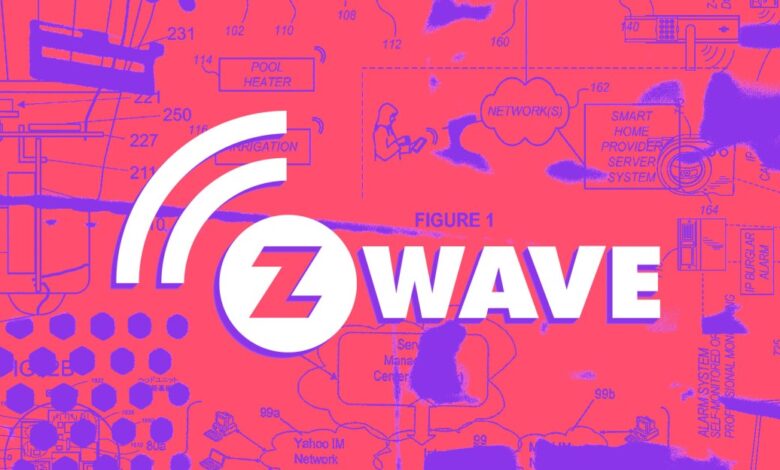Z-Wave is remaking itself to find a new place in your smart home

The invention of Matter was a grand kumbaya moment for the smart home. Built on the foundations of almost every concept smart home companies had dreamed up — from Apple’s HomeKit to Google’s Thread — the idea was to create a new technology on top of existing ones. One common standard to make it easier for manufacturers to build smart home devices and easier for people to use them, no matter which smart home platform they use.
But one protocol was left out of the party: Z-Wave, which is widely used in home security systems and embraced by the smart home enthusiast community. It was the latest example of Z-Wave getting left behind as the consumer smart home world explodes in popularity — and the latest reason to question whether the once-thriving standard still has a future.
Conceived in the late 1990s, Z-Wave is one of the original solutions for connecting IoT devices. It’s a local, RF-based wireless communications technology that relies on a central hub or gateway to talk to the cloud and other protocols. But that reliance on a hub is part of why it’s fallen out of fashion. You rarely see Z-Wave in mass-market smart home devices because other standards can connect straight to the internet. It was also a closed protocol, limited to one chip manufacturer, which could have driven up prices.
But in the five years since Matter launched, Z-Wave has been quietly reinventing itself. The once closed protocol is now open source. There’s a new version — Z-Wave Long Range (ZWLR) — that addresses a common limitation of the smart home by extending the range of devices like locks, lights, and sensors. Perhaps more importantly, the Z-Wave Alliance is now working on the structure and framework needed to bridge Matter and Z-Wave.
Today, Z-Wave is at a critical turning point. Apple, Amazon, Samsung, and Google are all-in on Matter, and Z-Wave isn’t present in any of those companies’ flagship products. If the standard is going to survive, its creators need to show it has a purpose that other protocols simply can’t match.
What is Z-Wave, and why should I care about long range?
Even if you’ve never heard of Z-Wave, it might be in your home. A mesh-based protocol focused on interoperability, reliability, privacy, and security, Z-Wave radios are found in most home security systems, including Amazon’s Ring, and smart home hubs from companies like Home Assistant, Aeotec, Hubitat, and Homey.
Z-Wave was embraced early on by the home security industry, including ADT, Vivint, Alarm.com, and others, which saw its security, baked-in interoperability, and backward compatibility as a way to allow customers to integrate smart home devices with their company’s proprietary security systems. It’s also the only UL-listed smart home protocol, a requirement for devices integrated into a security system.
”Everybody puts a Z-Wave chip in their security panel.”
“Every residential security system in the US, except one, uses Z-Wave,” says Avi Rosenthal, chair of the Z-Wave Alliance board of directors. “From your big Honeywells, ADTs, and Rings, all the way down to your little Alulas, everybody puts a Z-Wave chip in their security panel. The only exception is SimpliSafe.” Rosenthal says that by some estimates, Z-Wave is in 40 million homes in the US; there are also over 100 million Z-Wave devices in the wild worldwide.
Despite its sizable footprint, Z-Wave remains a niche protocol. Its reliance on a hub makes it less accessible to casual users accustomed to plug-and-play Wi-Fi and Bluetooth devices. And as a mesh network, multiple devices or repeaters are needed to ensure a stable connection, which can be an issue if you just want to install one door lock or light switch.
Z-Wave Long Range addresses some of these limitations. Introduced in 2020, and now beginning to appear in products, ZWLR extends range up to 1.5 miles line of sight — four times standard Z-Wave — and replaces mesh with the ability for all devices to connect directly to the hub, not to each other.
This should reduce failures caused by weak mesh networks or limited range. And, as all Z-Wave devices have to be backwards compatible, ZWLR can exist alongside Z-Wave mesh devices on a hub, as long as it supports both.
For smart home manufacturer Zooz, ZWLR has been a game changer. “Now we have ultra-reliable connectivity with unparalleled range,” says Agnes Lorenz, a VP at Zooz. Its direct hub-to-device communication means no need for repeaters, making existing devices more reliable and expanding the possibilities around outdoor devices, like motion sensors, leak detectors in the attic, and garage automation. “Now we can more easily automate things that are hard to access,” she says
Adoption is starting to ramp up, with over one hundred ZWLR-certified devices now on the market. Zooz transitioned its entire lineup to ZWLR, Shelly is also using the protocol, and the Z-Wave Alliance is working on expanding it to Europe. Just last month, Kwikset introduced two new long-range smart locks.
“This is one of the most compelling Z-Wave updates,” says Joshua Hodgson, product marketing manager at Kwikset. “Over a mile range versus 300 feet for standard mesh means connectivity challenges are no longer an issue.”
But does Z-Wave Matter anymore?
Even as the tech improves, Z-Wave’s biggest problem is that relatively few direct-to-consumer companies are implementing it in their devices.
While manufacturers such as Kwikset, who have used the protocol for years, still see Z-Wave as vital despite Matter’s rise, the fact is that there are very few “fun” Z-Wave gadgets out there. Much of what does exist are simple, utilitarian devices like sensors, lights, switches, and locks. There hasn’t been a splashy new Z-Wave product in years, and if you are looking to start a smart home with Amazon, Apple, or Google hardware, Z-Wave is just not part of the equation. That doesn’t look like it’s going to change anytime soon.
However, there is a hope for Z-Wave’s future in a Matter world. While Z-Wave’s reliance on a hub has arguably been its biggest barrier to adoption, Matter’s initial promise of a hub-free world hasn’t materialized. Matter controllers are essentially hubs, as are Thread border routers — both are necessary to use Matter devices. The smart home has come back around to the idea that you need a small computer somewhere in your home to run your devices. If these hubs must exist, why not include Z-Wave?
“Ultimately, it’s all about consumer choice,” says Jeff Sandoval of Kwikset. With Matter sparking renewed interest in smart homes, the idea of a universal hub to unify devices is gaining traction (again). Many advanced smart home hubs — including Homey, Home Assistant, and Hubitat — support both Z-Wave and Matter, but they remain niche. To survive, Z-Wave needs to co-exist with Matter and find its way into mainstream consumer products like smart speakers.
One strategy is to bridge Z-Wave devices into Matter ecosystems like Apple Home, Home Assistant, and Amazon Alexa, similar to how Philips Hue, Ikea, and Aqara are bridging devices to Matter. While bridging has been part of the spec since Matter launched, Rosenthal says it’s not been possible to certify a Matter Z-Wave bridge.
“There are plenty of silicon solutions available today, but nothing has been ‘blessed’ by both alliances,” says Mariusz Malkowski of Trident IoT, the newest Z-Wave chipmaker, which also manufactures chips for Matter, Thread, and Zigbee. “We want to simplify the process for manufacturers to make a commercial product to support both Z-Wave, Zigbee, Thread, and Matter.”
While some Z-Wave-compatible hub manufacturers have found ways to connect Z-Wave and Matter devices in their ecosystems, there’s no official way to integrate them, meaning there’s no simple, straightforward way to use Z-Wave devices in mainstream Matter ecosystems.
“Reports of our death have been greatly exaggerated.”
The Connectivity Standards Alliance tells The Verge that it welcomes the Z-Wave Alliance’s efforts here. “We are happy to see efforts to make the adoption of Matter easier for manufacturers and consumers, including simpler ways to bridge devices to Matter,” says the CSA’s Daniel Moneta. Rosenthal says the Z-Wave Alliance is actively working on certification parameters and rules to define a standard Z-Wave to Matter bridge for its members.
Once this standard is released, adding Z-Wave devices to Matter ecosystems will become simpler. Manufacturers will just need to add a software stack to their hubs that, as long as it contains a Z-Wave radio, could bridge Z-Wave devices connected to the hub to any Matter platform, including Apple Home and Google Home.
The benefit is that if Z-Wave devices integrate with Matter, it will help bring Matter’s ambition of “one smart home standard to rule them all” closer to reality. That would both strengthen Matter’s position in the industry and give Z-Wave a compelling reason to stick around. “So that, to the consumer, everything magically works,” says Malkowski.
Z-Wave isn’t a threat to Matter. With the majority of the smart home industry behind it, Matter still has plenty of momentum despite some early stumbles. However, without support from Matter, Z-Wave could become obsolete. Maybe not anytime soon, but the possibility exists. Bringing Z-Wave into Matter would be better for everyone — manufacturers and smart home users alike.
In the meantime, Z-Wave is pushing forward with its reinvention, hoping to find its role in this brave new world. Its new long-range capabilities, shift to an open-sourced standard, and finally having more than one silicon vendor make this a much easier path. As Rosenthal puts it, “Reports of our death have been greatly exaggerated.”






